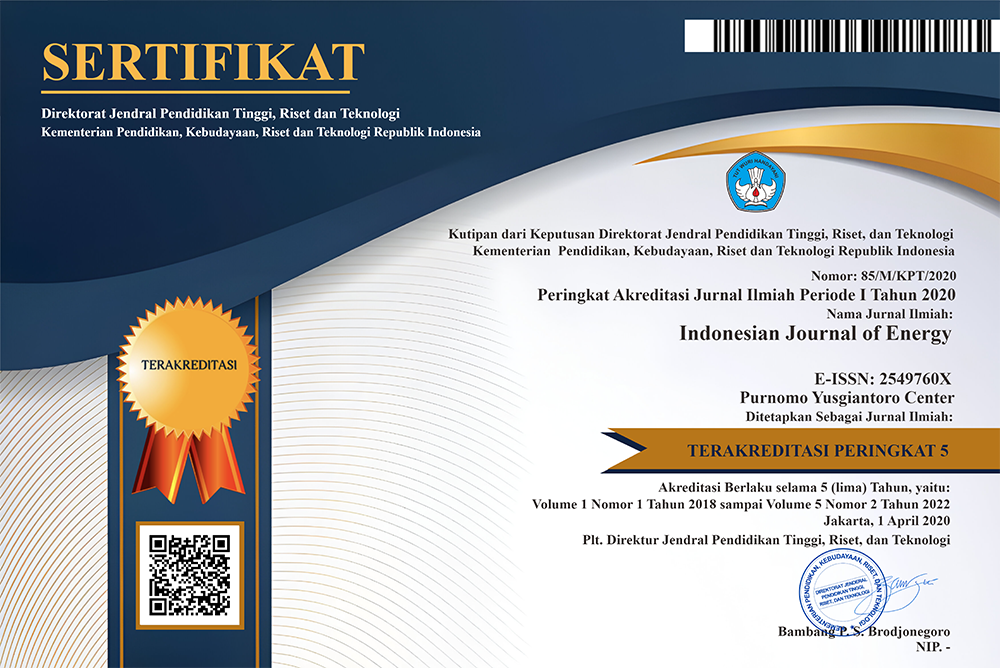Estimations of the Geothermal Energy Potential in The Mount Anak Krakatau Region Based on Derivative Analysis and 3D Model of Gravitational Satellite Data
Abstract
Geothermal energy is a source of renewable energy that has the potential to be produced, considering that Indonesia is in the ring of fire, where there are many volcanoes, one of which is Mount Anak Krakatau. Even though direct exploration is not permitted, at least information on the geothermal system on the mountain can still be obtained using satellite data. Therefore, this study aims to analyze the geothermal energy potential of Mount Anak Krakatau using gravity satellite data with a total of 320 data consisting of gravity disturbance, geoid, and Digital Elevation Model. The data processing describes a 3D model that is correlated with the First Horizontal Derivative (FHD) and Second Vertical Derivative (SVD) analysis. Based on the results of the residual anomaly map analysis, the low anomaly has a value of -1.85–(-0.89) mGal which is suspected to be associated with magma pockets, and the high anomaly ranges from 0.04–2.13 mGal which is suspected to be associated with the caldera of Mount Anak Krakatau. Based on the results of the FHD and SVD graphical analysis, there are 18 faults that control the geothermal system. Based on the results of 3D modeling trending from west-east it can be seen that there is a clay cap layer with a value density 2.32–2.37 gr/cc at depths of 0–550 m and reservoir layers with density values of 2.23–2.29 gr/cc at depths of 500–1100 m. This geothermal research using the gravity method can be developed and become a reference for future research to calculate the potential for electrification in a research area.
Downloads
References
Anggraeni, F. K., Astutik, S., Nurlyan, M. R., Utami, R. D., Putri, O. Z., & Maudina, D. (2023). Identifikasi struktur bawah permukaan Gunung Semeru pasca erupsi tahun 2022. Jurnal Ilmu dan Inovasi Fisika, 7(1), 69–77.
Ariyanti, O. & Fattah, R.M. (2020). The process of establishing and activities of the Anak Krakatau Mountain. Geographica: Science & Education Journal, 2(1), 46–54.
Aufia, Y. F., Karyanto, and Rustadi. (2019). Pendugaan patahan daerah “Y” berdasarkan anomali gaya berat dengan analisis derivative. Jurnal Geofisika Eksplorasi, 5(1), 75–88.
Buijze, L, et al. (2019). Review Of induced seismicity in geothermal systems worldwide and implications for geothermal systems in the Netherlands. Netherlands Journal of Geosciences, 98(13). https://doi.org/10.1017/njg.2019.6
Camacho, M., & Alvarez, R. (2021). Geophysical modeling with satellite gravity data: Eigen-6C4 vs. GGM Plus. Engineering, 13(12), 690706. https://doi.org/10.4236/eng.2021.1312050
Citraningrum, Y. P., et al, (2023). Subsurface interpretation of the Sembalun Area, East Lombok using the gravity method. Cognizance Journal of Multidisciplinary Studies, 3(11), 1–8.
Cordell, L. (1979). Gravimetric expression of graben faulting in Santa Fe Country and the Espanola Basin, New Mexico. Guidebook to Santa Fe Country. In: Ingersoll, R.V., Ed., New Mexico Geological Society Guidebook: 30th Field Conference, 59–64.
Dewi, C. N., Maryanto, S., & Rachmansyah, A. (2015). Sistem panasbumi daerah Blawan, Jawa Timur berdasarkan survei magnetotelurik. Jurnal RISET Geologi dan Pertambangan, 25(2), 111–119. https://doi.org/10.14203/risetgeotam2015.v25.262
Firdaus, A., Harmoko, U., & Widada, S. (2014). Pemodelan steady state sistem panas bumi daerah sumber air panas Diwak-Derakan dengan menggunakan software hydrothrem 2.2. Youngster Physics Journal. 3(4), 243–250.
Fitriani, D. S., Putri, S. N. A., & Putrajy, I. F. (2020). Metode gravitasi untuk identifikasi Sesar Weluki dengan analisis first horizontal derivative dan second vertical derivative. Prosiding Seminar Nasional Fisika (SNF), IX, 53–60. https://doi.org/10.21009/03.SNF2020.01.FA.10
Gunawan, B., Anjani, A., & Anjalni, A. (2022). Identifikasi pemodelan 2d dan suhu permukaan daerah panas bumi
Gunung Gede-Pangrango, Jawa Barat menggunakan metode gravitasi. Journal of Engineering Environmental Energy and Science, 1(1), 1–14.
Hirt, C., Claessens, C., Fecher, T., Kuhn, M., Pail, R., & Rexer, P. (2013). New ultra-high resolution picture of 2 Earth's gravity field. Geophysical Research Letters, 40, https://doi.org/10.1002/
grl.50838
Indriani, R. F., Anjasmara, I. M., Utama, W., Rafi, M. E. D., & Gaol, D. J. L. (2023). Geological structure model for recharge area in Patuha Geothermal Field. IOP Conf. Series: Earth and Environmental Science. 1276 012052. https://doi.org/10.1088/1755-1315/1276/1/012052
Nafian, M., Gunawan, B., & Permana. N.R. (2021). 2D forward modeling geothermal system gravity data in South Solok Region, West Sumatra. Al-Fiziya. Journal of Materials Science, Geophysics, Instrumentation and Theoretical Physics, 36–44.
Perwita, C. A., Maryanto, S., Ghufron, M., Prakoso, M., Abigail, S., & Zamhar, U. Z. N. (2020). Korelasi peningkatan temperatur permukaan tanah dan aktivitas seismik di Gunung Anak Krakatau pada tahun 2018. Jurnal Lingkungan dan Bencana Geologi, 11(3), 135–142.
Putra, P. S. & Yulianto, E. (2017). Karakteristik endapan tsunami krakatau 1883 di daerah Tarahan, Lampung. Jurnal RISET Geologi dan Pertambangan, 27(1), 83–95.
Rachmawati, F. A., Haryanto, A. D., Hutabarat, J., & Sumaryadi, M. (2019). Penentuan sumber panas sistem panas bumi Gunung Api Talang, Sumatera Barat berdasarkan sejarah panas dan geokimia air. Padjajaran Geoscience Journal, 3(1), 44–50.
Raharjo, S. A., Saputra, A. V., & Rahadinata, T. (2022). Identifikasi struktur geologi bawah permukaan berdasarkan pemodelan 3D data gravitasi (studi kasus daerah potensi panas bumi Kepahiang). Jurnal Teras Fisika, 5(2), 28–35. https://doi.org/10.20884/1.jtf.2022.5.2.7248
Ramadhan, A. B., Djayus, D., & Lepong, P. (2020). Analisa struktur bawah permukaan daerah prospek panas bumi “GF-TNH” Sumatera Barat berdasarkan metode gaya berat. Jurnal Geosains Kutai Basin, 3(1), 1–10. https://doi.org/10.30872/geofisunmul.v3i1.594
Rizkiani, D. N., & Rustadi. (2019). Interpretasi sistem panas bumi Suwawa berdasarkan data gaya berat. Jurnal Geofisika Eksplorasi, 5(2), 42–52.
Saad, S. N., (2022). Studi geokimia batuan gunung api Anak Krakatau hasil erupsi Desember 2018. Universitas Hasanuddin.
Sigfússon, B., & Uihlein, A. (2015). Technology, market and economic aspects of geothermal energy in Europe. The European Union.
Sumintadireja, P. (2012). GL3142: Volkanologi dan geotermal. Penerbit ITB.
Suprianto, A., Supriyadi., Priyantari, P., & Cahyono., B. E. (2021). Correlation between GGMPlus, Topex and BGI gravity data in volcanic areas of Java Island. Journal of Physics: Conference Series. 1825 012023. https://doi.org/10.1088/1742-6596/1825/1/012023
Sutawidjaja, I. S. (2006). Pertumbuhan Gunung Api Anak Krakatau setelah letusan katastrofis 1883. Jurnal Geologi Indonesia, 1(3), 143–153.
Syafawi, I., Suhendi, C., & Yudistira, T. (2015). Identifikasi tubuh magma Gunung Api Anak Krakatau berdasarkan struktur kecepatan seismik 3D menggunakan tomografi gempa lokal. Institut Teknologi Sumatera.
Telford, W. M., Eldart, L. M., & Sheriff, R. E. (2004). Applied geophysics (2nd Edition). Cambridge University Press.
Tim Badan Geologi. (2019). Dinamika geologi Selat Sunda dalam pembangunan berkelanjutan. Badan Geologi, Kementerian Energi dan Sumber Daya Mineral.
Utama, W., Putra, D. P. N., Garini, S. A., & Indriani, R. F. (2023). Optimizing surface lithology interpretation from global gravity model and landsat 8 satellite imagery in Semeru Mountain, Indonesia. IOP Conf. Series: Earth and Environmental Science. 1276 012048. https://doi.org/
1088/1755-1315/1276/1/012048
















